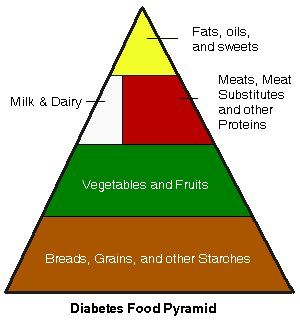Diabetes Food Pyramid - Food Groups and Sample Serving Sizes
The Diabetes Food Pyramid groups foods according to their carbohydrate and protein content instead of the better-known "food groups." For example, cheese is a protein rather than a dairy product (as in the regular Food Guide Pyramid). Serving portions are also different because they are based on carbohydrates per serving.

Breads, Grains and Other Starches: 6 to 11 servings per day.
Included in this group: bread, oats, rye, cereals, rice, pasta, plus starchy vegetables like corn, peas, and potatoes.Sample serving sizes:
- 1 slice of bread
- 1 oz. bagel (approximately 1/4 of an average-sized bagel)
- 3/4 cup dry cereal
- 1/2 cup cooked cereal
- 1/3 cup pasta or rice
- 1/2 cup potato
Vegetables (3 to 5 servings) and Fruits (2 to 4 servings).
Included in this group: most vegetables and fruits. The exceptions are starchy items like potatoes and corn, which belong in the Starches group.Sample serving sizes:
- 1/2 cup cooked veggies, or 1 cup raw
- 1 small piece of fruit
- 1 cup of melon
- 2 tablespoons of dried fruit
- 1/2 cup of canned fruit.
Milk and Diary Products (2 to 3 servings, with an emphasis on low-fat products).
Included in this group: milk, yogurt. Cheese is not a part of this group, but rather included in the Meat group due to its protein content.Sample serving sizes:
- 1 cup of skim milk
- 1 cup of yogurt.
Meats and Meat Substitutes (4 to 6 ounces - emphasis on lean meats)
Included in this group: beef, pork, chicken, turkey, fish, eggs, tofu, cheese, cottage cheese, peanut butter, and dried beans.Sample serving sizes (1 ounce, approximately the size of a deck of cards):
- 1 ounce of any meat (try to aim for lean meats like skinless chicken breasts and fish)
- 1 egg
- 1 tablespoon of peanut butter
- 1/2 cup of tofu
- 1/4 cup of cottage cheese.
Fats, sweets, and alcohol (consume sparingly).
Included in this group: treats like potato chips, cookies, candy, cakes, etc. Also includes alcohol and oil (including that which you use in cooking).Sample serving sizes:
- Two small cookies
- 1/2 cup of ice cream.
Watch a registered dietician explain the diabetic food pyramid - she gives some great easy tips on how to measure your portions.
It's all about balance. You can still eat a varied diet with lots of tasty foods... it's just a matter of learning how to balance the carbohydrates in your meals, whether those carbs come from breads, pastas, starchy vegetables, or other sources.
The Diabetes Food Pyramid is only a guideline. As a part of your diabetes treatment plan, consult with a dietitian to develop an individualized eating plan with appropriate portion sizes.
What Causes Diabetes?
Insulin Resistance
Signs of Diabetes
Hypoglycemia
Hyperglycemia
Glycemic Index
Diabetic Recipes
Feline Diabetes
Diabetes Diet Sheet
How to Control Diabetes Without Medication
What Foods Have a Low Glycemic Index?
Conversion Chart for Blood Sugar Levels





